The problem with normal wheelchairs is that they damage your arms and shoulders and using them outdoors on suburban sidewalks is not much fun – so you don’t go out. E-assist chairs are great, but they don’t give you much exercise – and they still damage your arms.
We tested Octal Wheels against a standard manual wheelchair and reported the findings.
- Over suburban sidewalks, it goes three times as fast as a normal manual wheelchair.
- It needs only a third of the force.
- It has only a tenth of the jerk (this is what hurts you).
- It gives you a full cardio workout.
- The novel cross-slope control device removes that problem.
Below is the proof of all this.
Here is an academic paper. Reading is believing. The paper has been Peer reviewed.
Claire L. Flemmer & Rory C. Flemmer (02 Nov 2023): Reinventing the wheel for a manual wheelchair, Disability and Rehabilitation: Assistive Technology https://doi.org/10.1080/17483107.2023.2272851
Technical
We tested the performance of the wheelchair on three subjects: a 75-year-old man, a 61 year old woman and a 30 year old man. We will test more widely but the results from these three subjects are interesting
Firstly, we compared the input force for this chair with that of a standard chair. This (blue) standard wheelchair graph was lifted from the technical literature (3). These tests represent the effort required to propel the chair along a smooth, level path at 1.3 metres per second – that is quite brisk for a MWC.
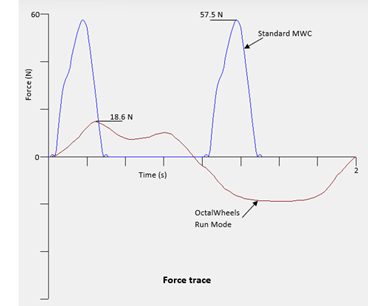
One of the two graphs shows a spike that happens every second as the MWC user grabs the pushrim and gives it a push. We are plotting two second’s worth. The maximum force was measured at 57.5 Newtons. (That’s 5.9 kg or 13 pounds). The smooth curve is for this chair. It takes two seconds per full stroke, one second with the hand moving forward (above the line) and the other with the hand moving back (below the line). The area between the curves and the X-axis is the same for both curves because the same amount of work is done to get the chair along the same path. However, you can see that the peak force for this chair is only 18.6 Newtons (1.9 kg or 4 pounds). That’s about one third of the MWC force and is a very pleasant experience for the shoulders.
If you look carefully, you can see that the MWC has a slight bump on the curve, corresponding to grasp and release. This experience is bad for your carpal tunnels in the long run. For our chair, there is no grasp and release.
It is reported (1) that the most important factor contributing to user pain is pulse – or jerk. Pulse means how jerky the motion is. We measure this as how fast the force changes. If it changes slowly, the pulse is small. If it spikes, like the jumpy graph, the pulse is high.
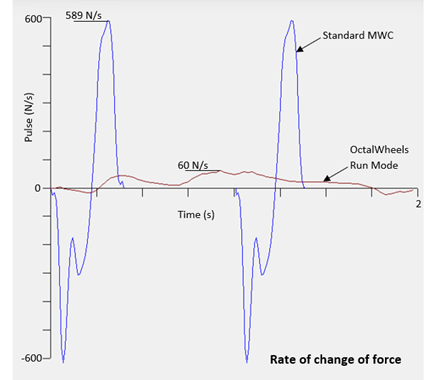
This plot shows the difference between a MWC and our chair. For the MWC, the peak pulse was 589 Newtons per second versus only 60 N/S for ours. The bottom line is that a MWC needs three times the force and inflicts ten times the pulse compared with this chair. A MWC would never be allowed in a factory. Health and Safety would become very shrill.
We also measured the biometrics of going around a rough course 1060 metres (1200 yards) long. We had the three able bodied subjects walk briskly, use this chair, briskly, and use a MWC, briskly. For the two tests in wheelchairs, the subject went as fast around as they could – they were trying to get exercise. You couldn’t go faster in the MWC because the faster you went, the more your arms were flailing around – and one arm got tired from the cross-slope.
Here are the several measures.
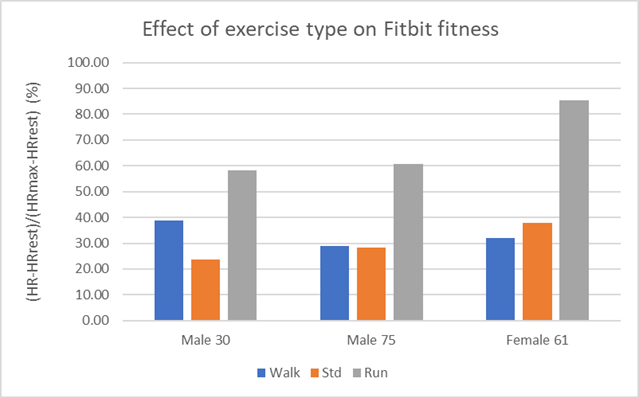
For this graph, we plotted heart rate the way Fitbit does. Hearts can go at resting speed or with exercise, they can go up to maximum speed, which varies with age. On the Y axis we have plotted where the heart rate is between these limits. You can see that all three subjects barely broke a sweat in walking or using a MWC but they got well into the cardio range with Octal Wheels. They could have gone slower with Octal Wheels, and got less exercise but were using it as an exercise machine – and because it was fun to go fast. With a MWC, you can go as if the Devil were after you and you can push your heart rate up, but you would be damaging your shoulders and one arm would be getting very tired from cross slope. And the bottom line is that people just don’t do that – because its no fun.
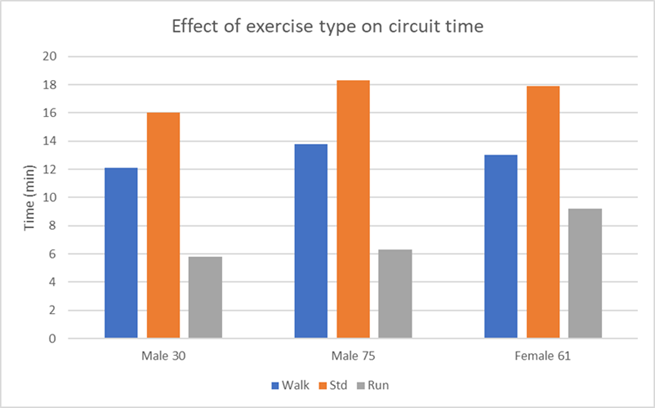
Here is a plot of how long it took for the three subjects to do a circuit (1060m). It is apparent that, in our chair, it took a third to a half of the time that it took in a MWC.
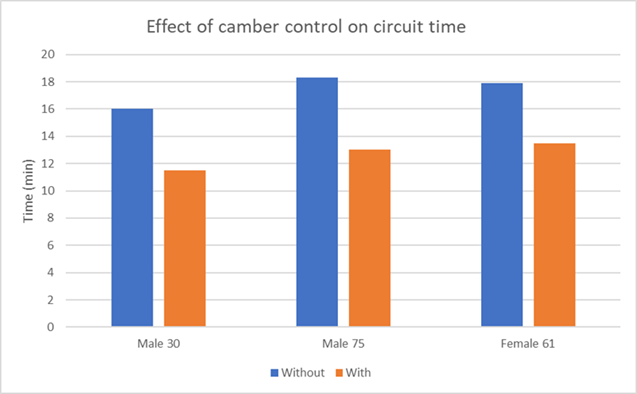
And here’s a plot showing the death of cross slope. The blue plot shows how long it took to go around the circuit on Octal Wheels in normal mode (same as a MWC), without setting the cross-slope control device. The subjects hated it because one arm got sore and tired. The orange graph is for the case where the cross-slope device was set. Subjects went faster without any whining about sore arms because the effort on each arm was equal.
If you study this data, you will see several things. They are very important, so consider each very well.
- All the subjects travelled over a 1.06 km rough course something like two to three times faster in this wheelchair than in a standard wheelchair, and getting towards a speed of twice walking speed.
- Octal Wheels required about a third of the force required for a MWC.
- Octal Wheels subjected the user to about one tenth of the jerk and damage of a MWC.
- All subjects got their heart rate well up into the cardio zone when they used this wheelchair for exercise, but not when they walked or when they used a normal wheelchair. The American Heart Association recommends that you spend 22 minutes a day in the fat-burn zone or above. That is to say, above about 38% on the fitbit graph above. With this chair, it is easy and fun. The run just doesn’t hurt, and when a 75-year-old says that, it really is something. With a MWC, getting into the cardio zone would be a sign of true grit. (And sore shoulders)
- Our cross-slope control really works.
References:
- Beirens BJ, Bossuyt FM, Arnet U, van der Woude LH, de Vries WH. Shoulder pain is associated with rate of rise and jerk of the applied forces during wheelchair propulsion in individuals with paraplegic spinal cord injury. Archives of Physical Medicine and Rehabilitation 2021;102(5): 856-864.
- Jayaraman C, Moon Y and Sosnoff J. Shoulder pain and time dependent structure in wheelchair propulsion variability. Medical Engineering and Physics 2016; 38:648-655.
- Robertson RN, Boninger MD, Cooper RA, Shimada SD. Pushrim forces and joint kinetics during wheelchair propulsion. Arch Phys Med Rehabil 1996;77: 856-864.
- Zukowski LA, Roper JA, Shechtman O, Otzel DM, Hovis PW, Tillman MD. Wheelchair ergonomic hand drive mechanism use improves wrist mechanics associated with carpal tunnel syndrome. J Rehabil Res Dev2014;51(10): 1515-1524.
- Kemp BJ, Bateham AL, Mulroy SJ, Thompson L, Adkins RH, Kahan JS. Effects of reduction in shoulder pain on quality of life and community activities among people living long-term with SCI paraplegia: a randomized control trial. J Spinal Cord Med 2011;34(3): 278-284.
- Goodwin BM, Jahanian O, Cain SM, Van Straaten MG, Fortune E, Morrow MM. Duration of static and dynamic periods of the upper arm during daily life of manual wheelchair users and matched able-bodied participants: a preliminary report. Frontiers in sports and active living 2021;3: 603020.
- Jahanian O, Gaglio A, Cho CC, Muqeet V, Smith R, Morrow MMB, Hsiao-Wecksler E T, Slavens BA. Hand-rim biomechanics during geared manual wheelchair propulsion over different ground conditions in individuals with spinal cord injury. J Biomechanics 2022 doi: https://doi.org/10.1016/j.jbiomech.2022.111235
